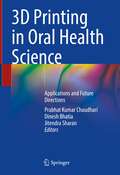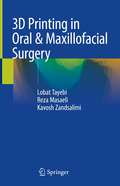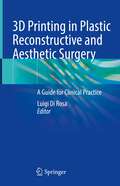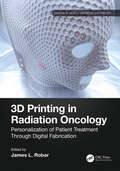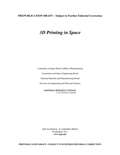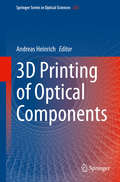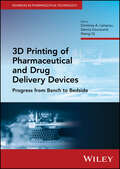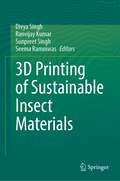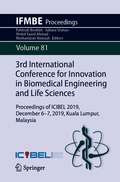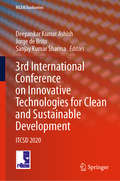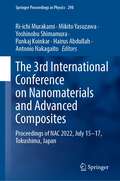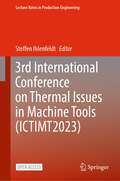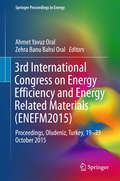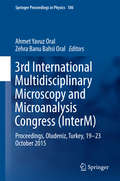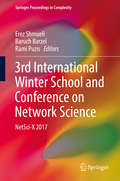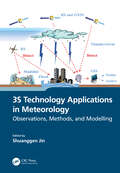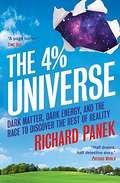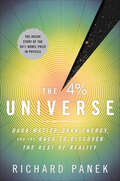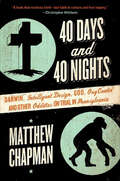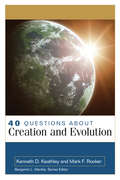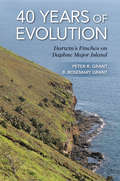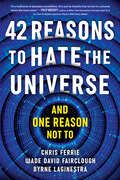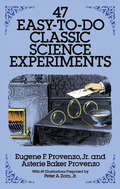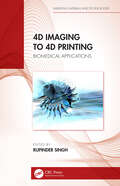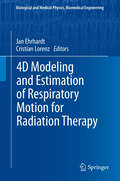- Table View
- List View
3D Printing in Oral Health Science: Applications and Future Directions
by Prabhat Kumar Chaudhari Dinesh Bhatia Jitendra SharanThis book on 3D printing in oral health science aims to equip the reader with a sound understanding of contemporary clinical applications in all fields of dentistry and their future directions. In the last few years, the development of 3D printing for medical and dental applications has increased tremendously. Advancements in 3D printing create the possibility of customized products, savings on small-scale productions, ease of sharing and processing of patient image data, and educational up-gradation. Looking at the dental specialties, it is evident that 3D printing has applications in all aspects of oral health science including prosthodontics, oral surgery, periodontics, endodontics, and orthodontics. This book will cover all major fields in dentistry and will help the practitioner in the process of decision-making and apply concepts in clinical or laboratory practice. It is based on current scientific evidence to provide readers with an up-to-date contemporary understanding of the subject, both from the clinical and the technological side. The book is a valuable asset for all who specialize in 3D printing and for those interested in learning more about this field.
3D Printing in Oral & Maxillofacial Surgery
by Lobat Tayebi Reza Masaeli Kavosh ZandsalimiThis book is a comprehensive guide to 3D printing and 3D bioprinting methods and their application in oral and maxillofacial surgeries. Among the 3D printing methods considered are fused deposition modeling, selective laser sintering, photopolymer jetting, powder binder printing, and stereolithography, while the coverage of 3D bioprinting encompasses inkjet, microextrusion, and laser techniques. In each case, the relevance of the technique to oral and maxillofacial surgery is explained. In addition, the available inks and bioinks for 3D printing are reviewed. The roles of soft and hard tissue printing in oral and maxillofacial tissue engineering and the use of 3D printing in multi- and interfacial tissue engineering are then examined in depth. The particular value of 3D printing in the treatment of critically sized defects is discussed separately. Finally, up-to-date information is provided on guided tissue/bone regeneration using 3D printing. The book will be of interest to both oral and maxillofacial surgeons and biomedical engineers.
3D Printing in Plastic Reconstructive and Aesthetic Surgery: A Guide for Clinical Practice
by Luigi Di RosaThis handy volume illustrates the basics of clinical three-dimensional (3D) printing, addressing the practical aspects of establishing a simple and effective 3D printing service in a medical facility. No longer confined to makers and workshops, this very recent technology has been fast developing and rapid prototyping has proven its potential in the clinical field as well, leading to new approaches. The declared aim of this work is enabling medical professionals to create bespoke anatomical models from a series of CT or MRI images, and assisting them in choosing the best suited 3D printers and materials for each specific clinical need. The text includes original, full-color step-by-step photos for better guidance, and a complete review of related publications in literature. Single chapters devoted to specific areas of 3D printing application, such as rhinoplasty, ear reconstruction, oculoplasty, maxillofacial surgery, as well as for surgical simulations. Contents are completed by a review of the legal aspects and the safety and quality considerations, as well as a thorough examination of the variety of 3D printers, compatible materials as filaments and resins, and including the available online resources. Plastic, Ophthalmologic and Maxillofacial surgeons, and professionals dealing with surgical reconstruction, will find this guide to be a valuable companion for the understanding of 3D printing in clinical practice.
3D Printing in Radiation Oncology: Personalization of Patient Treatment Through Digital Fabrication (Imaging in Medical Diagnosis and Therapy)
by James L. Robar3D Printing in Radiation Oncology: Personalization of Patient Treatment Through Digital Fabrication presents a comprehensive and practical view of the many forms in which 3D printing is being integrated into radiation oncology practice. Radiation oncology employs among the most sophisticated digital technologies in medicine. Until recently, however, the “last mile” of treatment has required manually produced or generic devices for patient set up, positioning, control of surface dose, and delivery of brachytherapy treatment. 3D printing is already offering enhancements in both precision and efficiency through the digital design and fabrication of patient photon and electron bolus, customized surface and gynecological brachytherapy applicators, proton beam compensators and range shifters, patient immobilization, novel radiation detectors, and phantoms. Various innovations are disrupting decades-old practices in radiation therapy (RT) facilities, resulting in vital improvements in personalization of treatment and patient experience.An essential read for radiation oncologists, medical physicists, radiation therapists, oncology nurses, hospital administrators, engineers, and medical educators, this book is an indispensable resource for those bringing 3D printing to the RT clinic, looking to expand the role of 3D printing in their practice, or embarking upon related research and development.
3D Printing in Space
by Committee on Space-Based Additive ManufacturingAdditive manufacturing has the potential to positively affect human spaceflight operations by enabling the in-orbit manufacture of replacement parts and tools, which could reduce existing logistics requirements for the International Space Station and future long-duration human space missions. The benefits of in-space additive manufacturing for robotic spacecraft are far less clear, although this rapidly advancing technology can also potentially enable space-based construction of large structures and, perhaps someday, substantially in the future, entire spacecraft. Additive manufacturing can also help to reimagine a new space architecture that is not constrained by the design and manufacturing confines of gravity, current manufacturing processes, and launch-related structural stresses. The specific benefits and potential scope of additive manufacturing remain undetermined. The realities of what can be accomplished today, using this technology on the ground, demonstrate the substantial gaps between the vision for additive manufacturing in space and the limitations of the technology and the progress that has to be made to develop it for space use. "3D Printing in Space" evaluates the prospects of in-space additive manufacturing. This report examines the various technologies available and currently in development, and considers the possible impacts for crewed space operations and robotic spacecraft operations. Ground-based additive manufacturing is being rapidly developed by industry, and "3D Printing in Space" discusses government-industry investments in technology development. According to this report, the International Space Station provides an excellent opportunity for both civilian and military research on additive manufacturing technology. Additive manufacturing presents potential opportunities, both as a tool in a broad toolkit of options for space-based activities and as a potential paradigm-changing approach to designing hardware for in-space activities. This report makes recommendations for future research, suggests objectives for an additive manufacturing roadmap, and envisions opportunities for cooperation and joint development.
3D Printing of Optical Components (Springer Series in Optical Sciences #233)
by Andreas HeinrichThis edited volume reviews the current state of the art in the additive manufacturing of optical componentry, exploring key principles, materials, processes and applications. A short introduction lets readers familiarize themselves with the fundamental principles of the 3D printing method. This is followed by a chapter on commonly-used and emerging materials for printing of optical components, and subsequent chapters are dedicated to specific topics and case studies. The high potential of additive manufactured optical components is presented based on different manufacturing techniques and accompanied with extensive examples – from nanooptics to large scale optics – and taking research and industrial perspectives. Readers are provided with an extensive overview of the new possibilities brought about by this alternative method for optical components manufacture. Finally, the limitations of the method with respect to manufacturing techniques, materials and optical properties of the generated objects are discussed. With contributions from experts in academia and industry, this work will appeal to a wide readership, from undergraduate students through engineers to researchers interested in modern methods of manufacturing optical components.
3D Printing of Pharmaceutical and Drug Delivery Devices: Progress from Bench to Bedside (Advances in Pharmaceutical Technology)
by Dimitrios A. Lamprou Dennis Douroumis Sheng Qi3D Printing of Pharmaceutical and Drug Delivery Devices 3D Printing of Pharmaceutical and Drug Delivery Devices Discover the latest, fast-developing technology to help move towards more cost-effective, small-batch, decentralized manufacturing of personalized systems 3D printing has revolutionized manufacturing. Its precision and flexibility have enabled the large-scale production of materials and devices too complex for conventional industrial manufacturing. This has been particularly revolutionary in the field of pharmaceutical production, where 3D printing is being integrated into the manufacture of both drugs and drug delivery devices. It has never been more important for industry professionals to understand this form of production. 3D Printing of Pharmaceuticals and Drug Delivery Devices: Progress from Bench to Bedside offers a comprehensive overview of 3D printing technology and its pharmaceutical applications. It introduces readers to a world in which bespoke drug delivery systems developed for specific users or conditions is rapidly becoming a reality. Its detailed coverage of strategies and industrial processes incorporates the latest research and real-world experience of production. 3D Printing of Pharmaceuticals and Drug Delivery Devices: Progress from Bench to Bedside readers will also find: A multi-disciplinary authorial team of industry leadersDiscussion of common technical and regulatory barriers and their possible solutionsFar-ranging discussion of pharmaceutical applications across all sectors 3D Printing of Pharmaceuticals and Drug Delivery Devices: Progress from Bench to Bedside is essential reading for pharmaceutical industry professionals and researchers looking to occupy the leading edge.
3D Printing of Sustainable Insect Materials
by Divya Singh Ranvijay Kumar Sunpreet Singh Seema RamniwasThis book compiles a diverse and interdisciplinary range of scientific literature, laboratory developments, industrial implications and future prospects covering Entomophagy in 3D food printing to fight against hunger and nutritional deficiencies. Recent developments in Entomphagy in 3D printing of Drosophila based materials, and their nutritional, social, economic, scientific and environmental aspects. are comprehensively covered. Readers will also find shortcomings, guidelines, and industrial prospects for these materials, with emphasis on processing methods for the extraction of sustainable materials through 3D food printing. 3D Printing of Sustainable Insect Materials focuses on the methodology, technology and processing used for utilizing insects in 3D food printing applications, establishing technology-driven knowledge to fight against hunger. Chapters cover the principles for Entomophagy, insect processing methods, modern 3D food printing technologies, and the theoretical and practical aspects of Emtomophagy in 3D printing, with a special focus on future prospects and technologies. This ground-breaking book will serve knowledge to researchers and industry professionals across the food industry with broad coverage of emerging technologies, materials developed through Entomophagy, functional characterization and the technical details required to produce sustainable insect-based materials through 3D food printing.
3rd International Conference for Innovation in Biomedical Engineering and Life Sciences: Proceedings of ICIBEL 2019, December 6-7, 2019, Kuala Lumpur, Malaysia (IFMBE Proceedings #81)
by Fatimah Ibrahim Juliana Usman Mohd Yazed Ahmad Norhamizan HamzahThis book presents innovative engineering solution for medical diagnosis, therapy and life science studies. Gathering the proceedings of the 3rd International Conference for Innovation in Biomedical Engineering and Life Sciences, ICIBEL 2020, held on December 6-7, 2019, in Kuala Lumpur, Malaysia, this book aims at informing on engineering tools and their clinical applications, and being a source of inspiration for future research and interdisciplinary collaborations.
3rd International Conference on Innovative Technologies for Clean and Sustainable Development: ITCSD 2020 (RILEM Bookseries #29)
by Deepankar Kumar Ashish Jorge De Brito Sanjay Kumar SharmaThis book gathers peer-reviewed contributions presented at the 3rd International Conference on Innovative Technologies for Clean and Sustainable Development, held in Chandigarh, India, on February 19-21, 2020. The respective papers focus on sustainable materials science and cover topics including the durability and sustainability of concrete, green materials in construction, economics of cleaner production, environmental impact mitigation, innovative materials for sustainable construction, performance and sustainability of special concrete, renewable energy infrastructure, sustainability in road construction, sustainable concrete, sustainable construction materials, waste minimization & management, prevention and management of water pollution, and zero-energy buildings.
The 3rd International Conference on Nanomaterials and Advanced Composites: Proceedings of NAC 2022, July 15-17, Tokushima, Japan (Springer Proceedings in Physics #298)
by Ri-Ichi Murakami Mikito Yasuzawa Yoshinobu Shimamura Pankaj Koinkar Hairus Abdullah Antonio NakagaitoThis book presents selected articles from the 3rd International Conference on Nanomaterials and Advanced Composites (NAC 2022) held at Tokushima University in Japan. This event brought together leading researchers and professionals from academia and industry to present their latest findings and served as a platform for the exchange of ideas aiming for further collaborations. Participants from over six countries shared their most up-to-date knowledge in their respective fields covering nanotechnology, nanomaterials, and advanced composites. Even though this conference had both on-site and remotely connected attendees, the main purpose to promote the networking among academics, engineers, and students was fully achieved. This book is part of the effort to disseminate the knowledge gathered during this meeting. The collection of articles covers topics on advanced composites, nanomaterials, ecological materials, energy, microfluidics, crystal growth, and photocatalysis. This representative account of the conference is intended to provide new and useful insights for prospective studies in materials science and engineering.
3rd International Conference on Thermal Issues in Machine Tools (Lecture Notes in Production Engineering)
by Steffen IhlenfeldtThis open access conference proceedings contains all the papers presented at the ICTIMT 2023, the 3rd International Conference on Thermal Issues in Machine Tools. The event takes place in Dresden, the capital of Saxony, from March 21-23 2023. The conference is organized by the Chair of Machine Tools Development and Adaptive Controls of the Technische Universität Dresden.
3rd International Congress on Energy Efficiency and Energy Related Materials: Proceedings, Oludeniz, Turkey, 19–23 October 2015 (Springer Proceedings in Energy)
by Ahmet Yavuz Oral Zehra Banu Bahsi OralThe 3rd International Congress on Energy Efficiency and Energy Related Materials (ENEFM2015) was held from 19-23 October 2015. This congress focused on the latest developments of sustainable energy technologies, materials for sustainable energy applications and environmental and economic perspectives of energy. These proceedings included 40 peer-reviewed technical papers, submitted by leading academic and research institutions from over 23 countries and represented some of the most cutting-edge researches available. The sections included in the 40 papers are listed as follows: Solar Energy, Fuel cells, Hydrogen productions, Hydrogen storage, Energy storage, Energy saving, Biofuels and Bioenergy, Wind Energy, Nuclear Energy, Fossil Energy, Hydropower, Carbon capture and storage, Materials for renewable energy storage and conversion, Photovoltaics and solar cells, Fuel generation from renewables (catalysis), Carbon dioxide sequestration and conversion, Materials for energy saving, Thermoelectrics, Energy saving in buildings, Bio-Assessment and Toxicology, Air pollution from mobile and stationary sources, Transport of Air Pollutants, Environment-Friendly Construction and Development, Energy Management Systems.
3rd International Multidisciplinary Microscopy and Microanalysis Congress: Proceedings, Oludeniz, Turkey, 19-23 October 2015 (Springer Proceedings in Physics #186)
by Ahmet Yavuz Oral Zehra Banu Bahsi OralThe 3rd International Multidisciplinary Microscopy Congress (InterM2015), held from 19 to 23 October 2015, focused on the latest developments concerning applications of microscopy in the biological, physical and chemical sciences at all dimensional scales, advances in instrumentation, techniques in and educational materials on microscopy. These proceedings gather 17 peer-reviewed technical papers submitted by leading academic and research institutions from nine countries and representing some of the most cutting-edge research available.
3rd International Winter School and Conference on Network Science: NetSci-X 2017 (Springer Proceedings in Complexity)
by Erez Shmueli Baruch Barzel Rami PuzisThis book contains original research chapters related to the interdisciplinary field of complex networks spanning biological and environmental networks, social, technological, and economic networks. Many natural phenomena can be modeled as networks where nodes are the primitive compounds and links represent their interactions, similarities, or distances of sorts. Complex networks have an enormous impact on research in various fields like biology, social sciences, engineering, and cyber-security to name a few. The topology of a network often encompasses important information on the functionality and dynamics of the system or the phenomenon it represents. Network science is an emerging interdisciplinary discipline that provides tools and insights to researchers in a variety of domains. NetSci-X is the central winter conference within the field and brings together leading researchers and innovators to connect, meet, and establish interdisciplinary channels for collaboration. It is the largest and best known event in the area of network science. This text demonstrates how ideas formulated by authors with different backgrounds are transformed into models, methods, and algorithms that are used to study complex systems across different domains and will appeal to researchers and students within in the field.
3S Technology Applications in Meteorology: Observations, Methods, and Modelling
by Shuanggen JinSpatial information technology and its integration, such as remote sensing, geographic information systems (GIS), and global navigation satellite systems (GNSS), known as 3S technology, have been extensively utilized in managing and monitoring natural disasters. This book illustrates the 3S integrated applications in the field of meteorology and promotes the role of 3S in developing precise and intelligent meteorology. It presents the principles of 3S technology and the methods for monitoring different meteorological disasters and hazards as well as their application progress. The case studies from the United States, Japan, China, and Europe were conducted to help all countries understand the 3S technology functions in handling and monitoring severe meteorological hazards. FEATURES Presents integral observations from GNSS, GIS, and remote sensing in estimating and understanding meteorological changes Explains how to monitor and retrieve atmospheric parameter changes using GNSS and remote sensing Shows three-dimensional modelling and evaluations of meteorological variation processing based on GIS Helps meteorologists develop and use space-air-ground integrated observations for meteorological applications Illustrates the practices in monitoring meteorological hazards using space information techniques and case studies This book is intended for academics, researchers, and postgraduate students who specialize in geomatics, atmospheric science, and meteorology, as well as scientists who work in remote sensing and meteorology, and professionals who deal with meteorological hazards.
The 4-Percent Universe: Dark Matter, Dark Energy, and the Race to Discover the Rest of Reality
by Richard PanekIt is one of the most disturbing aspects of our universe: only four per cent of it consists of the matter that makes up every star, planet, and every book. The rest is completely unknown. Acclaimed science writer Richard Panek tells the story of the handful of scientists who have spent the past few decades on a quest to unlock the secrets of "dark matter" and the even stranger substance called "dark energy". These are perhaps the greatest mysteries in science,and solving them will reshape our understanding of the universe and our place in it. The stakes could not be higher. Panek's fast-paced narrative, filled with original, in-depth reporting and intimate, behind-the-scenes details, brings this epic story to life for the very first time.
The 4% Universe: Dark Matter, Dark Energy, and the Race to Discover the Rest of Reality
by Richard Panek"The centerpiece of The 4% Universe is a compelling narrative of science at its best… serve[s] handsomely as an illuminating guide to the dark mysteries lying at the heart of the intersection of astronomy and fundamental physics."—The Wall Street Journal "Impeccably researched and highly readable."—New Scientist "A model for all would-be popular-science writers."—Physics World "Panek's passion for the mysteries of dark matter and dark energy wins the day. He succeeds because he recognizes that he's writing not just about red shifts and supernovae, but about people...the success of The 4 Percent Universe also stems from Panek's wisdom about how science works."—The Washington Post "The balance between lively characters and provocative ideas keeps the book moving as quickly as any high stakes thriller, but the pay-off here is an answer of truly cosmic significance...the universe is keeping secrets from us--big secrets. Dark secrets. Panek's joyful journey through the wilds of modern cosmology gives us good reason to care about those secrets, and their sure-to-be surprising answers."—Ad Astra, Magazine of National Space Society"A superior account of how astronomers discovered that they knew almost nothing about 96 percent of the universe. Science writer Panek (The Invisible Century: Einstein, Freud, and the Search for Hidden Universes, 2005, etc.) points out that 50 years ago astronomers assumed they understood the cosmos and its history from the big bang to galaxy formation to its ultimate fate as expansion continued. One detail remained disturbing: Galaxies were moving too fast. Since gravity controls movements, they had to be heavier than predicted. By the 1980s, this "missing mass" problem became critical as it became clear that galaxies, including ours, were rotating so fast that missing mass far outweighs visible objects such as stars. Even after eliminating gas and dust, "dark matter" represents strange particles unknown to science. Astronomers also believed that gravity was slowing expansion of the universe but debated if galaxies would reverse themselves, continue to recede ever more slowly or (the favorite theory) simply stop. Panek describes frustrating struggles with high-tech detectors, complex computer algorithms and massive telescopes to search distant galaxies for the key. The answer came in the late '90s expansion wasn't slowing but speeding up. Flabbergasted astronomers understood that accelerating billions of galaxies requires immense energy. Since Einstein proved that energy and mass are equivalent, this "dark energy" makes up three-quarters of the universe. Dark energy added to dark matter reduces the familiar universe to 4 percent of the total. Panek delivers vivid sketches of scientists, lucid explanations of their work and revealing descriptions of the often stormy rivalry that led to this scientific revolution, usually a media cliche, but not in this case." —Kirkus Reviews, STARRED review"There has always been more to the universe than we can see. Science journalist Panek (The Invisible Century) offers an insider's view of the quest for what could be the ultimate revelation: the true substance of the unseen dark matter and energy that makes up some 96% of our universe. The search for these hidden elements began in the 1960s with astronomers asking whether the universe would end in an infinitely expanding "Big Chill" or a collapse into a "Big Crunch"--or whether the universe is a just-right "Goldilocks" space that would nurture stars and galaxies forever. To answer this question, scientists calculated the universe's mass and discovered there was far more mass than we could see. But where is this "missing mass" and what kind of exotic "dark" stuff is it made of? Panek gleefully describes a 'Wild West of the mind, where —
40 Days and 40 Nights: Darwin, Intelligent Design, God, Oxycontin®, and Other Oddities on Trial in Pennsylvania
by Matthew ChapmanIn this fascinating story of evolution, religion, politics, and personalities, Matthew Chapman captures the story behind the headlines in the debate over God and science in America.Kitzmiller v. Dover Board of Education, decided in late 2005, pitted the teaching of intelligent design (sometimes known as "creationism in a lab coat") against the teaching of evolution. Matthew Chapman, the great-great-grandson of Charles Darwin, spent several months covering the trial from beginning to end. Through his in-depth encounters with the participants—creationists, preachers, teachers, scientists on both sides of the issue, lawyers, theologians, the judge, and the eleven parents who resisted the fundamentalist proponents of intelligent design—Chapman tells a sometimes terrifying, often hilarious, and above all moving story of ordinary people doing battle in America over the place of religion and science in modern life.
40 Questions About Creation and Evolution (40 Questions & Answers Series)
by Kenneth Keathley Mark F. RookerBiblically and scientifically informed answers to pressing questions about the creation-evolution debateThis accessible volume evenly addresses the issues of modern science and the scriptural texts. The conservative evangelical authors are well-informed on contemporary scientific views of the universe and also carefully exegete the biblical texts that pertain to creation. They irenically consider the various angles of the debate and make constructive suggestions to reconcile science and the Bible.Those who are curious about the origins of life and the universe will want to read this book. Seminary students and serious college students will find this information critical, as an understanding of creation is vital to an effective apologetic in sharing the faith.
40 Years of Evolution: Darwin's Finches on Daphne Major Island
by Peter R. Grant B. Rosemary GrantAn important look at a groundbreaking forty-year study of Darwin's finchesRenowned evolutionary biologists Peter and Rosemary Grant have produced landmark studies of the Galápagos finches first made famous by Charles Darwin. In How and Why Species Multiply, they offered a complete evolutionary history of Darwin's finches since their origin almost three million years ago. Now, in their richly illustrated new book, 40 Years of Evolution, the authors turn their attention to events taking place on a contemporary scale. By continuously tracking finch populations over a period of four decades, they uncover the causes and consequences of significant events leading to evolutionary changes in species.The authors used a vast and unparalleled range of ecological, behavioral, and genetic data—including song recordings, DNA analyses, and feeding and breeding behavior—to measure changes in finch populations on the small island of Daphne Major in the Galápagos archipelago. They find that natural selection happens repeatedly, that finches hybridize and exchange genes rarely, and that they compete for scarce food in times of drought, with the remarkable result that the finch populations today differ significantly in average beak size and shape from those of forty years ago. The authors' most spectacular discovery is the initiation and establishment of a new lineage that now behaves as a new species, differing from others in size, song, and other characteristics. The authors emphasize the immeasurable value of continuous long-term studies of natural populations and of critical opportunities for detecting and understanding rare but significant events.By following the fates of finches for several generations, 40 Years of Evolution offers unparalleled insights into ecological and evolutionary changes in natural environments.
42 Reasons to Hate the Universe: (And One Reason Not To)
by Chris Ferrie Wade David Fairclough Byrne LaGinestraIf you've always suspected the universe was out to get you… you were right!Yes, the universe we live in is cosmically beautiful and mysterious and all that crap. But it's also a bit of an asshole. After all, remember that you are just a group of atoms structured in a specific way for barely long enough to try to understand this thing we call existence. Those atoms could just have easily been used to make the dog shit you're cleaning off your shoe or the mold that grows on your bread! The fact is, when you zoom out to look at the universe and how it functions, you'll see that it's usually not in our favor, and many of the laws of physics are actively working against our survival. In this book, you'll discover why:You're an aging mutantInvisible rays are melting our genetic codeThe Earth is covered in explosive pimplesLiterally everything is poisonousAnd more true and terrifying scientific facts!But don't worry! While it's true that there are (at least) forty-two grudges to hold against the universe, the good news is that there is also one very good reason to forgive them all and embrace the wild, improbable fact that we are alive (for now) and we should take advantage of it while we can. 42 Reasons to Hate the Universe (And One Reason Not To) is a hilarious, no-holds-barred exploration of all the reasons we shouldn't exist—but somehow do anyway. Rooted in scientific research but written simply so that evolved apes such as ourselves can understand where the heck we came from and where we're likely going, this book is for all the nerds and nihilists who know they're going down in the end but want to enjoy the rollercoaster ride of existence on the way.
47 Easy-to-Do Classic Science Experiments (Dover Children's Science Books)
by Eugene F. Provenzo Jr. Asterie Baker ProvenzoHere is a highly motivating book for grade-school students that will introduce them to many of the world's most popular (and historically significant) scientific experiments. They'll learn about gravity simply by following the acrobatic antics of an ordinary coin. By trying to blow an egg out of a cup, they'll discover the principles of air pressure. Dancing soap bubbles will help them understand the effects of static electricity, and by dropping quarters into a full glass of water without causing it to overflow, they'll study the effects of surface tension.These and over 40 other experiments have been carefully selected by noted educators Eugene and Asterie Baker Provenzo to familiarize children with classic science experiments involving optics, inertia, air pressure, magnetism, sound, topology, light, density, vibration, prisms, elasticity, gases, vacuum, perspective, geometry, centrifugal force, buoyancy, color, and much more. Some experiments, such as the optical "Newton's Rings" are hundreds of years old. Still others, like the straw lever test, are based on Greek experiments with leverage and the center of gravity -- first carried out thousands of years ago.Easy-to-follow instructions and illustrations show youngsters how to perform each experiment, most of which are prefaced with historical background, a list of necessary materials and an explanation of key terms. Almost all experiments can be carried out with common household items (tissue paper, scissors, tapes, rubber balloons, pens, pencils, etc.) and can be worked at home or in the classroom to demonstrate specific scientific principles or to supplement a science-curriculum unit. Sources for all historical illustrations given in the text are listed at the end of the book.
4D Imaging to 4D Printing: Biomedical Applications (Emerging Materials and Technologies)
by Rupinder SinghThis book focuses on applications of 4D imaging and 4D printing for development of low-cost, indigenous lab-scale solutions for various biomedical applications. It is based on a selection of benchmark open-source 4D imaging solutions including the effect of different stimulus (such as light, electric field, magnetic field, mechanical load, thermal, hydro, and so forth) to better understand 4D capabilities of printed components. The material is covered across nine chapters dedicated to 4D imaging, 4D printing, and their specific biomedical applications illustrated via case studies related to orthopaedic and dental requirements of veterinary patients. The book: •Presents exclusive material on the integration of 4D imaging and 4D printing•Demonstrates the industrial applications of 4D imaging in 4D printing using multiple case studies•Discusses use of open-source 4D imaging tools for biomedical applications•Includes in-house development of smart materials for 4D printing•Reviews low-cost, indigenous lab-scale solutions for various veterinary applications. This book is aimed at graduate students and researchers in Additive Manufacturing, Manufacturing Engineering, Production Engineering, Mechanical Engineering, and Materials Engineering.
4D Modeling and Estimation of Respiratory Motion for Radiation Therapy (Biological and Medical Physics, Biomedical Engineering)
by Cristian Lorenz Jan EhrhardtRespiratory motion causes an important uncertainty in radiotherapy planning of the thorax and upper abdomen. The main objective of radiation therapy is to eradicate or shrink tumor cells without damaging the surrounding tissue by delivering a high radiation dose to the tumor region and a dose as low as possible to healthy organ tissues. Meeting this demand remains a challenge especially in case of lung tumors due to breathing-induced tumor and organ motion where motion amplitudes can measure up to several centimeters. Therefore, modeling of respiratory motion has become increasingly important in radiation therapy. With 4D imaging techniques spatiotemporal image sequences can be acquired to investigate dynamic processes in the patient's body. Furthermore, image registration enables the estimation of the breathing-induced motion and the description of the temporal change in position and shape of the structures of interest by establishing the correspondence between images acquired at different phases of the breathing cycle. In radiation therapy these motion estimations are used to define accurate treatment margins, e.g. to calculate dose distributions and to develop prediction models for gated or robotic radiotherapy. In this book, the increasing role of image registration and motion estimation algorithms for the interpretation of complex 4D medical image sequences is illustrated. Different 4D CT image acquisition techniques and conceptually different motion estimation algorithms are presented. The clinical relevance is demonstrated by means of example applications which are related to the radiation therapy of thoracic and abdominal tumors. The state of the art and perspectives are shown by an insight into the current field of research. The book is addressed to biomedical engineers, medical physicists, researchers and physicians working in the fields of medical image analysis, radiology and radiation therapy.
